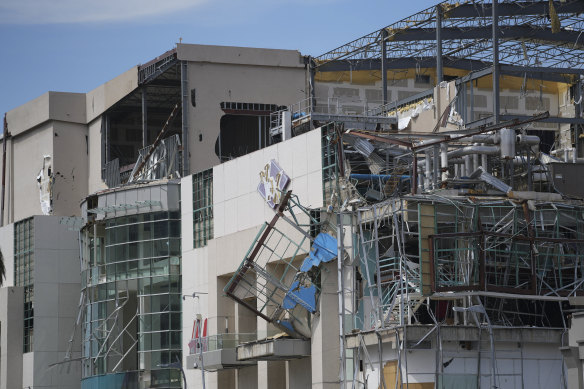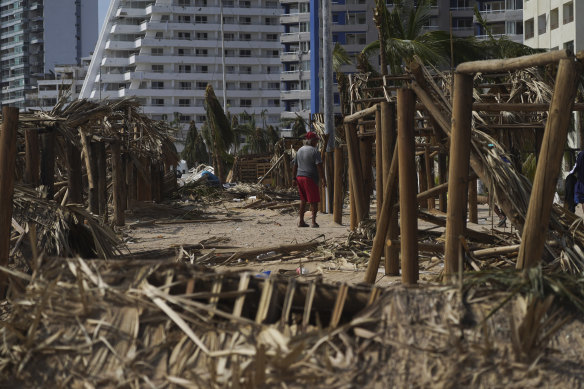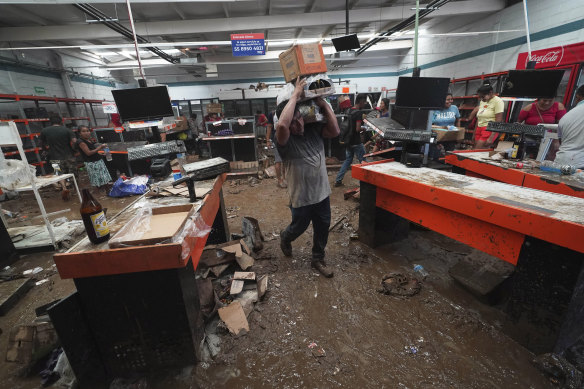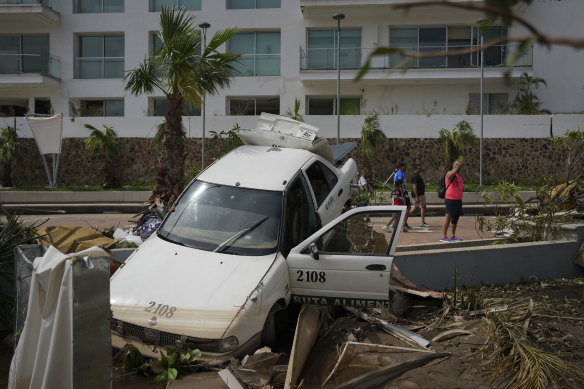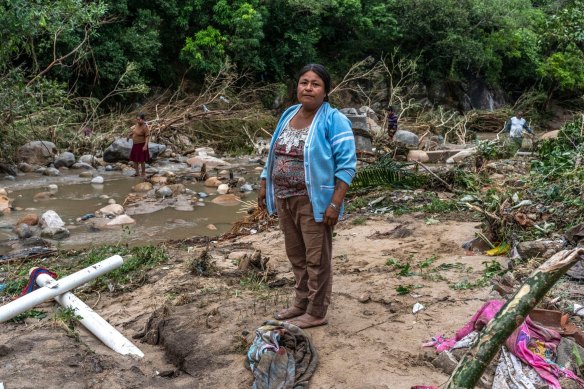Hurricane Otis turns popular Acapulco into a scene of chaos
Save articles for later
Add articles to your saved list and come back to them any time.
Acapulco: Sitting in his empty cab as another taxi driver pushed it from behind, Miguel Ángel Dorantes surveyed the scene of devastation left by the most powerful hurricane to hit the Pacific coast of Mexico, wondering if he would be able to reach home. Mudslides blocked off his hillside house in Acapulco. Basic goods were scarce because of aggressive looting following the storm.
“We have no gas, no water, no food,” he said, as people ran past his car and other gridlocked vehicles, carrying bottles of water, bags of beans and anything else from nearby stores. “Everything has been looted. There’s nothing to take any more.”
Damaged buildings stand after hurricane Otis ripped through Acapulco, Mexico.Credit: AP
The extent of the destruction left by hurricane Otis, which turned a once popular tourist destination into a scene of chaos, only started to come into view that morning. More than two dozen people were killed and three were missing after the storm made landfall in the early hours of Wednesday (US time) with an intensity that shocked forecasters and government officials.
Thousands of military officers, medical teams and government officials confronted a devastated Guerrero state the next day. Communication and power systems remained largely off in much of the state, making the scope of the hurricane’s toll difficult to ascertain.
“We are very sorry for the loss of 27 human beings,” President Andrés Manuel López Obrador said during his daily news conference in Mexico City after making a brief visit to the disaster area. “That is what hurts the most because the material can be taken care of, and we are going to do it with great responsibility.”
Tourism infrastructure on the beach lays in shambles in Acapulco.Credit: AP
The hurricane struck with little warning after growing with astonishing speed from a tropical storm into a Category 5 hurricane, packing sustained winds of 265 km/h when it made landfall.
Authorities were particularly concerned about Acapulco, a port city of more than 852,000 people on the Pacific coast and the largest city in Guerrero state. Acapulco was hosting an international mining industry convention when the storm hit. In addition, many hotels were packed with tourists.
Photographs and videos showed ravaged hotel rooms, doors ripped from hinges and furniture scattered throughout city streets.
Frightened tourists hid in their resorts, as the hurricane collapsed ceilings and shattered windows. Roughly 80 per cent of hotels in Acapulco were damaged by the storm, according to Evelyn Salgado Pineda, the governor of Guerrero.
Winds ripped trees and utility poles from the ground, Obrador said, adding that Acapulco remained without power, communication and water. Beaches that once brought visitors from all over the world were now covered in piles of debris. Many streets turned into rivers of mud. More than 200 patients had to be moved out of damaged hospitals, Rosa Icela Rodriguez, the national secretary of security and citizen protection, said.
People loot a supermarket after the storm in Acapulco.Credit: AP
Mexican authorities said that more than 8000 members of the armed forces had been deployed to the area, but the desperation was clear in Acapulco’s outer neighbourhoods. On the outskirts, residents could be seen carrying bags of food, toilet paper and mattresses through waist-deep flooded streets. Some people carried boxes of beer and alcohol out of a convenience store, and one group of men hoisted a safe. Some even took empty shelves from the stores.
Closer to the city, people rushed to the few stores and warehouses that had not yet been ransacked. In Central de Abasto, one of Acapulco’s main supply centres for markets, restaurants and homes, people walked out of warehouses with their hands full of goods.
Nearby, Guillermo Domínguez Reyes, 18, stood helplessly in the middle of a discount store where he started working only a month ago as a cashier. Nothing remained but mud, empty fridges and shelves. “I really just showed up to see if they counted my workday,” he said, wiping the sweat from his forehead.
A damaged car lies on a street split by Otis in Acapulco. The hurricane that strengthened swiftly before slamming into the coast as a category 5 storm has killed at least 27 people as it devastated the resort city.Credit: AP
Since the storm, he and his parents, who live nearby, have been growing more desperate to find food and water, he said. But he had refused to steal from businesses or stores.
“I’d rather go hungry than do this,” he said, expressing surprise that the store had been emptied in only one day. “More than anything because of my morals, because of my beliefs.”
Obrador said the federal government would begin delivering food to the area by air. Search and rescue teams were also sent to survey Acapulco and the surrounding mountainous region, which is susceptible to landslides.
But efforts to rebuild the damaged communities of Guerrero could face challenges made more difficult after Obrador overhauled Mexico’s Natural Disaster Fund, a pool of federal money for emergency relief. The president made the move two years ago in his push for budget cuts across the federal government.
A resident surveys damage where a home once stood, in the aftermath of hurricane Otis in Xaltianguis, Guerrero state, Mexico.Credit: Bloomberg
By law, the fund received 0.4 per cent of the federal budget every year, and if the money went unspent, then it rolled into the next year. Now the country no longer has a regulated per cent of the federal budget meant for disaster relief. Instead, the budget is revised every year and fluctuates based on other priorities.
Studies found that the fund had helped to quickly restore health services and eased bottlenecks in delivering disaster aid.
Obrador grew animated, as he defended his decision, calling the fund a “petty cash box” that was at the disposal of “corrupt politicians”.
During his visit to Acapulco on Wednesday evening, he encountered a mudslide and a flooded river. Photographs showed him walking in the mud as he visited a nearby community.
“There were many sinkholes, the highway was broken in several parts,” López Obrador said. “We got stuck there, we had to walk on foot, the people were very supportive.” He said the damage was the worst in Acapulco.
Zoé Robledo, director-general of the Mexican Social Security Institute, said on Wednesday that he had deployed an emergency team of nurses who had recently worked in Haiti.
“We are also preparing personnel teams for conservation issues: medicine supply, personnel strengthening, focusing on the patients,” Robledo said.
Otis rapidly intensified on Tuesday and into the early hours of Wednesday, developing from a tropical storm with winds of 104 km/h to a Category 5 storm with winds 160 km/h faster in less than 24 hours. After walloping the coastline, the storm dissipated as it headed inland over southern Mexico.
Forecasters and Mexican authorities were shocked by the magnitude of the storm. Their models largely failed to predict that it would intensify so abruptly, creating what Eric Blake, a forecaster with the National Hurricane Centre, called a “nightmare scenario” in a forecast he wrote on Tuesday night.
“It is unprecedented in the country in recent times,” Obrador said.
This article originally appeared in The New York Times.
Most Viewed in World
From our partners
Source: Read Full Article

